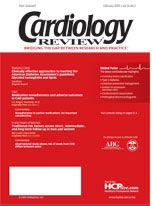Publication
Article
Myocardial vasodilatation index after statin treatment
A 61-year-old woman with hyperlipidemia but no history of heart disease or chronic diseases was admitted to our hospital. She had no symptoms or signs of coronary artery disease (CAD), including negative results on exercise stress testing. She agreed to participate in our study using positron emission tomography (PET) and [13N]-ammonia to assess the myocardial vasodilatation index (MVI) in response to dipyridamole loading. The patient was treated with simvastatin (Zocor; 10 mg/day) for 10 months. The plasma total cholesterol concentration decreased after simvastatin treatment, from 307 mg/dL before therapy to 212 mg/dL after therapy, as did the plasma low-density lipoprotein (LDL) cholesterol level (from 222 mg/dL before to 134 mg/dL after) and plasma triglycerides (165 mg/dL before to 143 mg/dL after). Plasma high-density lipoprotein (HDL) cholesterol concentration was similar before (52 mg/dL) and after (49 mg/dL) therapy. A dynamic PET perfusion study showed that baseline myocardial blood flow (MBF; mL/min/100 g heart weight) before simvastatin therapy (66.0 mL/min/100 g) was comparable with MBF after therapy (75.7 mL/min/100 g). MBF during dipyridamole administration before therapy (145.4 mL/min/100 g) improved after simvastatin therapy (376.0 mL/min/100 g). MVI as determined by a ratio of MBF during dipyridamole administration to baseline MBF before therapy (2.20) significantly increased after therapy (4.97). Static PET myocardial perfusion images at rest and during dipyridamole loading did not show any regional perfusion abnormality.
A 49-year-old man with hyperlipidemia but no history
of heart disease or chronic diseases was admitted to our hospital for treatment of hyperlipidemia. He had no symptoms or signs of CAD, including negative results on exercise stress testing. He agreed to participate in our study. After treat-ment with 20 mg/day of pravastatin (Pravachol) for 10 months, the plasma total cholesterol (266 mg/dL before
therapy versus 222 mg/dL after therapy), plasma LDL cholesterol (168 mg/dL before versus 118 mg/dL after) and
plasma triglyceride (206 mg/dL before versus 160 mg/dL after) levels improved. Plasma HDL cholesterol concentration also improved (57 mg/dL before versus 74 mg/dL after). However, a dynamic PET myocardial perfusion study with [13N]-ammonia and a two-compartment tracer kinetic model1* showed that baseline MBF before pravastatin therapy (63.0 mL/min/100 g) was comparable with that after the therapy (61.0 mL/min/100 g). MBF during dipyridamole administration also did not change (100.0 mL/min/100 g before therapy versus 106.0 mL/min/100 g after therapy), nor did MVI (1.59 before versus 1.63.0 after). Static PET myocardial perfusion images at rest and during dipyridamole loading did not show any regional perfusion abnormality.
It has been well recognized that hyperlipidemia can reduce MVI in patients without symptoms and signs of heart disease.2-7 It has also been reported that lipid-lowering therapy can improve MVI in hyperlipidemic patients.8-11 However, studies have been inconsistent. For example, it has been reported that pravastatin cannot improve MVI in hyperlipidemic patients,12 whereas fluvastatin (Lescol)9 and simva-statin can.10,11 Apart from reducing cholesterol, the secondary effects of statins appear to differ between simvastatin and pravastatin. Our results suggest that simvastatin but not pravastatin can improve impaired MVI in patients with hyperlipidemia.
